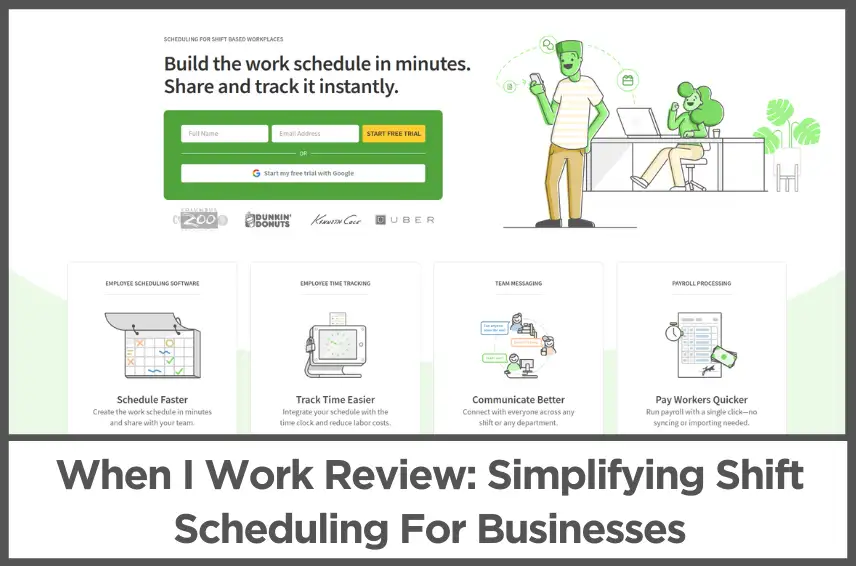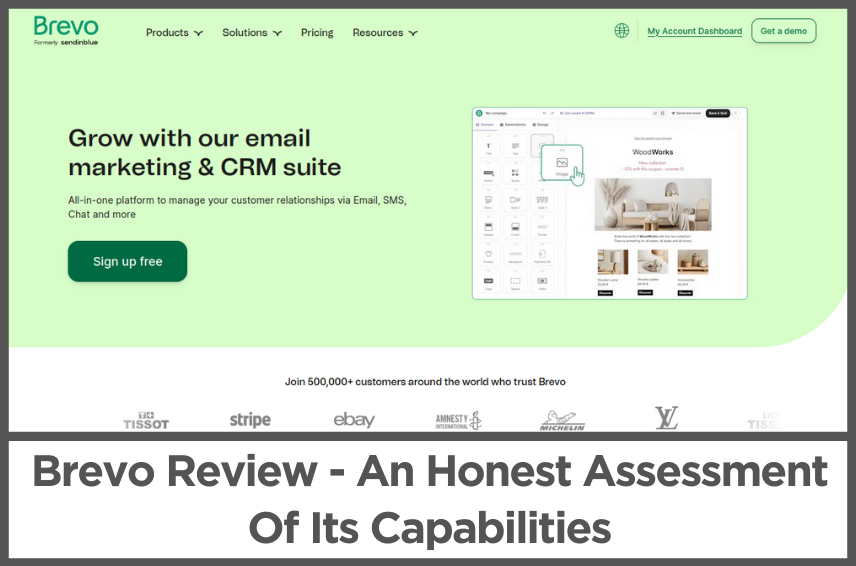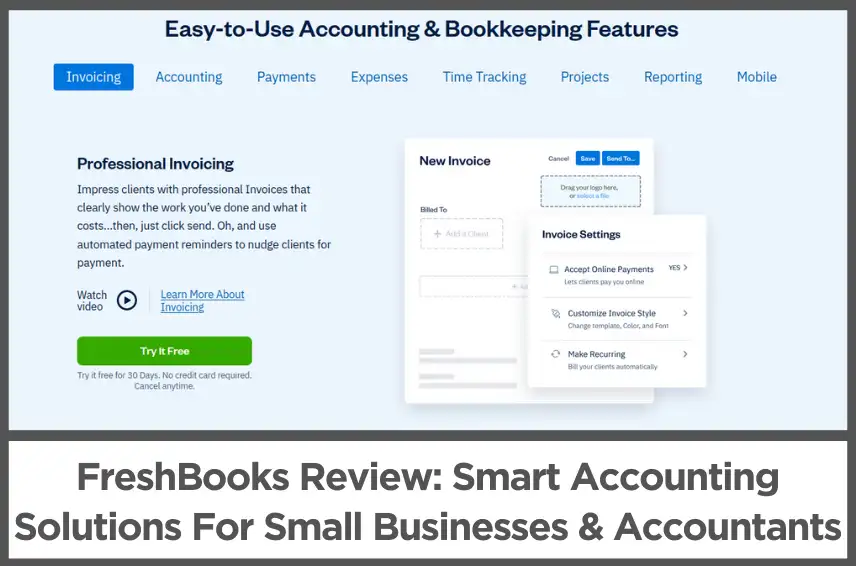Bluehost Review (Jul, 2024) – 11 Pros and 4 Cons You Should Know
by Abhigyan
Quick Look

Uptime
Even though its average uptime is around 99.9%, minor outages are sometimes observed but they are resolved quickly within 15 minutes.

Perfomance
Not the fastest host of all when it comes to server loading, but it offers enough speed to suit the needs of most new bloggers and light websites.

Support
Access to 24/7/365 customer support via numerous platforms, including live chat, emails, phone calls and social media support. But no free site migration.

Price
Initial rates are more budget-friendly than most other web hosting companies, but renewal rates are higher.
If you are planning to launch a new website for your business or a new blog, you are likely to be browsing through the internet in a quest to search for a reliable web host.
And I am sure you have come across a lot of BlueHost reviews on the Internet.
I have been using BlueHost shared hosting service since 2014 to build portfolio websites for local shops and college students.
In my opinion, BlueHost is a one-stop-shop, particularly for newbies looking for budget hosting, as it provides great uptime coupled with affordable pricing plans, and much more.
In this article, I’ll give you a much more in-depth and an unbiased overview of Bluehost.
Disclosure: Some of the links I share might be affiliate links. If you click on one and make a purchase, I may earn a small commission as a thank you. But don’t worry, it won’t cost you anything extra. I only recommend stuff I genuinely believe in. Your support helps me keep creating awesome content. You can read my full affiliate disclosure in my disclaimer page.
Over the years, Bluehost has become very popular as it is easy to use and beginner-friendly, which is an excellent trait in a web hosting service.
Also, it has an excellent track record of reliability, uptime, performance, affordability, and its brilliant features that help in your website’s growth.
BlueHost started in 1996 as a free hosting company called 0catch.com. The Bluehost you know today was renamed in 2003.
Currently, it has more than 750 employees and hosts over 2 million websites worldwide.
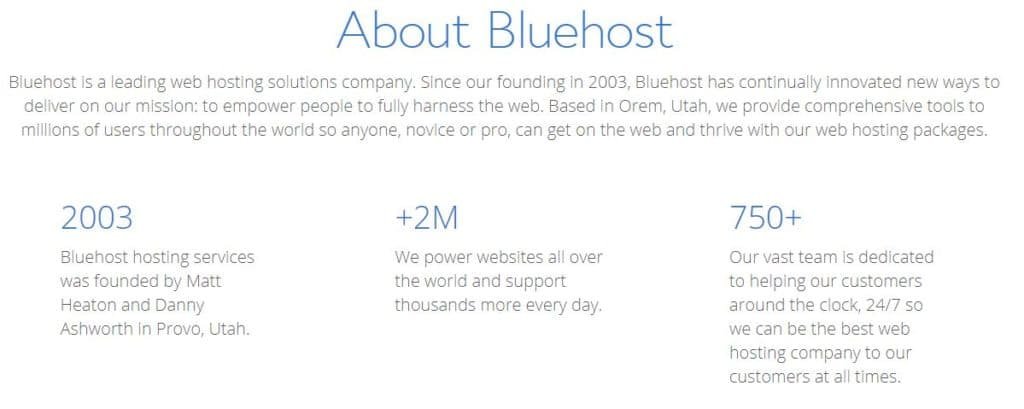
For over 10 years, Bluehost and WordPress have worked together to maintain support staff that helps out WordPress users.
Bluehost has also invested in an engineering team which is committed to WordPress core development.
Thus, Bluehost is able to provide its users with affordable and top-notch WordPress hosting.
IN THIS POST :
TogglePros: Why I Like BlueHost Hosting
1. Excellent server performance: Avg hosting uptime above 99.95%
Never take the risk of losing income and providing a poor user experience by investing in web hosting services that may fail you with their server downtime eventually.
As the industry-standard uptime for hosting companies is around 99%, make sure you always choose a web host which have an excellent track record of maintaining uptime which is above the industry-standard level.
BlueHost hosting performance have impressed me as they are able to maintain 99.95% uptime for my sites throughout the years.
You can see from the images below how BlueHost has been achieving 99.95% uptime consistently for a long time.

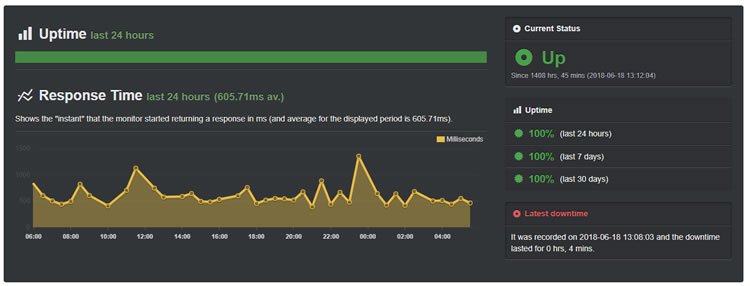
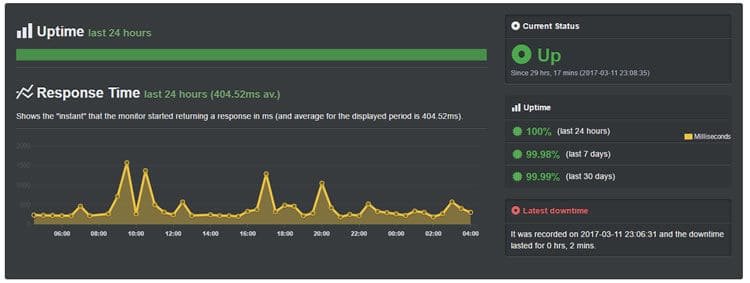
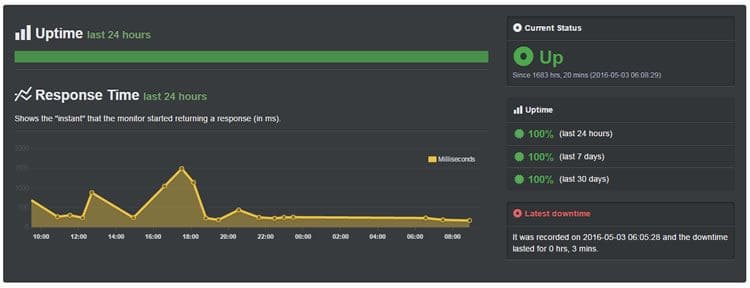
Having said that, I’ve experienced some minor outages a few times in the past year but those issues got resolved automatically within 10-15 minutes.
As per social media reviews, Bluehost’s other plans like cloud hosting and dedicated servers provide an uptime of nearly 100%.
However, Bluehost doesn’t mention anything specifically on its official website.
On their network/server uptime agreement page, they have claimed that they resolve most issues related to server downtime within 15 minutes.
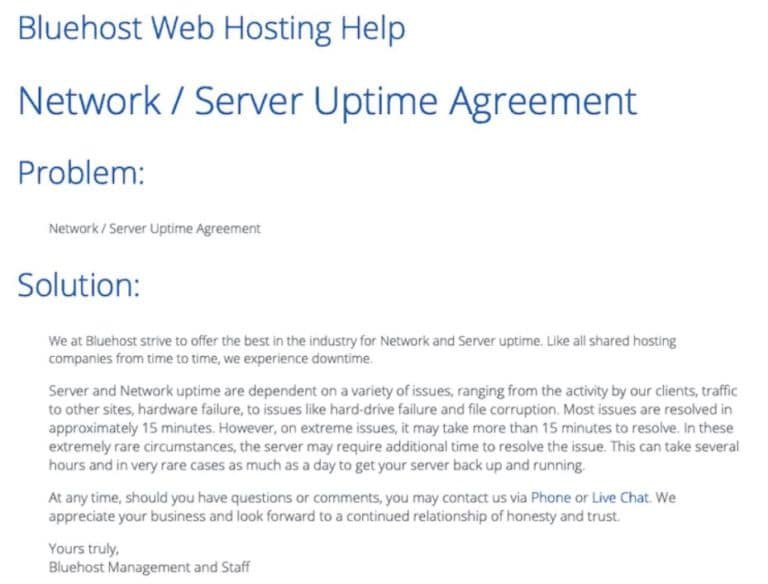
2. BlueHost speed meets expectation
Unlike web hosts like SiteGround, Bluehost isn’t the fastest host of all when it comes to server loading, but it offers enough speed to suit the needs of most website owners.
Again, the loading speed will depend on the type of hosting you will be using. For instance, if you go for shared hosting, the load times and response times will be slightly slower than a dedicated server.
I personally consider load times of less than 2 seconds to be decent, less than 1 seconds great, and less than 500 ms to be incredible.
When it comes to server speed, BlueHost performance meets my expectations. With an average Time-To-First-Byte (TTFB) of below 200ms – 600ms on Webpage Test, BlueHost is rated as “A” in most WebpageTest.org speed tests.
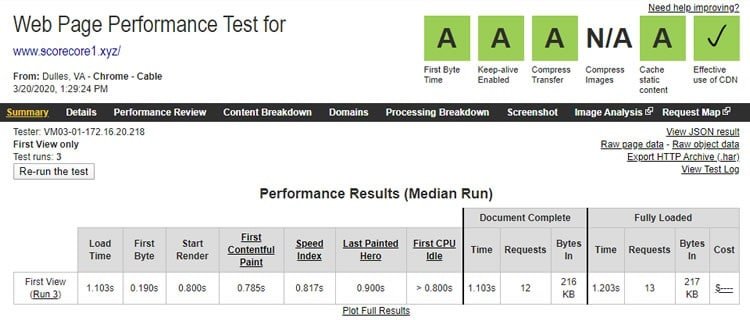

3. 24/7 Customer Support and Comprehensive Video Tutorials
Bluehost provides access to 24/7/365 customer support via numerous platforms, including:
- Live Chat
- Phone Calls
- Emails
- Ticketing System
- Social Media Support
The easiest way to get in touch with a qualified tech support professional who can help you settle your issues would be use their phone support.
You can also use the live chat option, but in my experience, the waiting time is comparatively longer in that case.
However, most of the time, you won’t even need any professional help. There are a lot of tutorials and self-documents available online, which makes BlueHost a lot easier to learn and use if you’re a beginner.
I was able to solve several simple issues by just reading their articles or watching the video tutorials in the past.

4. Officially recommended by WordPress.org
If your website is built on either WordPress, BlueHost will be a great fit for you as it is officially recommended by WordPress.
At present, WordPress powers over 30% of the internet and that is why it’s safe to say that they do not endorse just about anyone.
With a host that has been in the scene for more than 20 years, you are more at peace knowing that they will readily sort out any issues that you might face and the service will be streamlined.
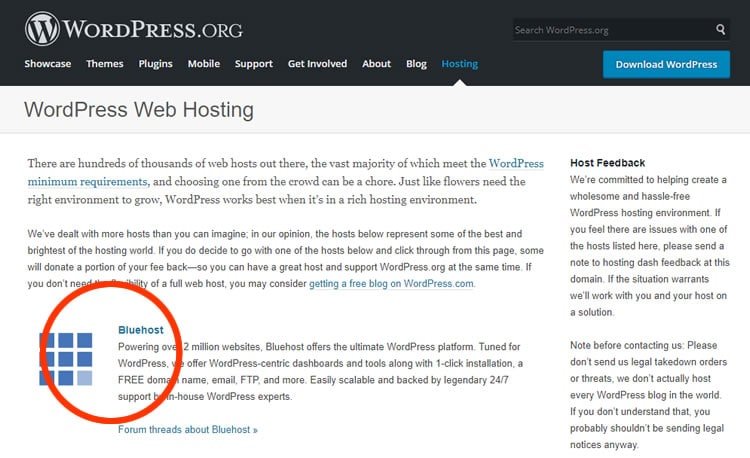
5. Free SSL Certificates
SSL is necessary for websites right now. If your website doesn’t have an SSL (i.e. isn’t served using the HTTPS protocol), browsers like Google Chrome will display a security warning to people, which may lead to higher bounce rate.
Security is essential for a website as it not only protects your website from hackers and malware, it also tells your users that their data are safe on your website.
Bluehost’s SSL Certificate is powered by Let’s Encrypt, and each certificate works to protect the connection between websites and your visitors.
All BlueHost plans come with a free SSL certificate. So rest assured, your personal information, eCommerce transactions, and other sensitive data will be protected at all times.

6. Beginner-friendly: Easy to use control panel and helpful emails
My on-boarding experience with BlueHost was great. They activated my account instantly and I also received helpful starter guide via emails everyday for the next 5 days after signup.
The Bluehost control panel is organized and easily navigable, easy for both beginners and experienced webmasters alike.
They have a clutter-free, user-friendly interface and ensures that all the technical elements are well explained.

7. Plenty of room for growth
Bluehost has plans for every type of business, small and large. Even if you start by using their cheapest plan, you can always scale up your site without facing the need to change your hosting provider.
You can drive as much traffic to your websites as possible without paying extra charges.
Also, you can either upgrade to a higher tiered plan, or start a new plan altogether. For instance, you can move from shared hosting to dedicated hosting without facing any downtime during the move.
See plan details in the following table:
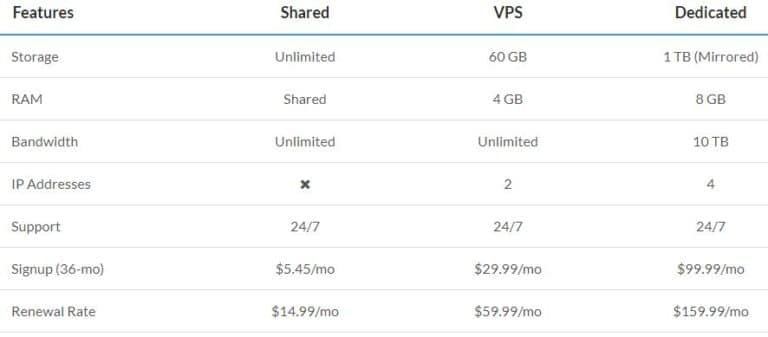
8. Automated Daily Backups
With any BlueHost plan, you get daily backups and website restorations. Many website owners overlook backups until it’s too late despite it being a crucial element.
But one thing to note here is that Bluehost’s backups are limited, but you can always upgrade if you require or make use of third-party backup software and have no worries about losing your site’s data.
9. Effective Security Measures and Resource Protection
BlueHost outsources its security protection to Cloudflare, which has an excellent track record and is a popular name in the content delivery network (CDN) industry.
BlueHost also offers plenty of other impressive security measures, such as SiteLock, daily scans to protect against viruses and malware, constant monitoring on servers, a free SSL certificate, password protected directories, and more.
Moreover, BlueHost’s technology identifies the websites that use excessive resources and temporarily reassigns them to isolated systems.
This feature secures your website performance and further minimises the risks that are usually associated with shared servers.
10. Extensive Plugin Library
BlueHost’s application library is very extensive and has various services and software. Apart from enabling ecommerce functionality and CloudFlare, it also allows you to plug your hosting account into Google Apps.
If you wish to add more functionality to your site and hosting account, Bluehost’s app library has multiple options.
11. 30-days Money-Back Guarantee
If you are not satisfied with the web host, BlueHost offers a 30-day money-back guarantee; no hidden terms applied.
However, please note that you will have to cancel within the 30-days of your sign-up to get a full refund.
If you cancel after the 30-day guarantee period is over, then you will gain you a prorated refund for the remainder of your term.
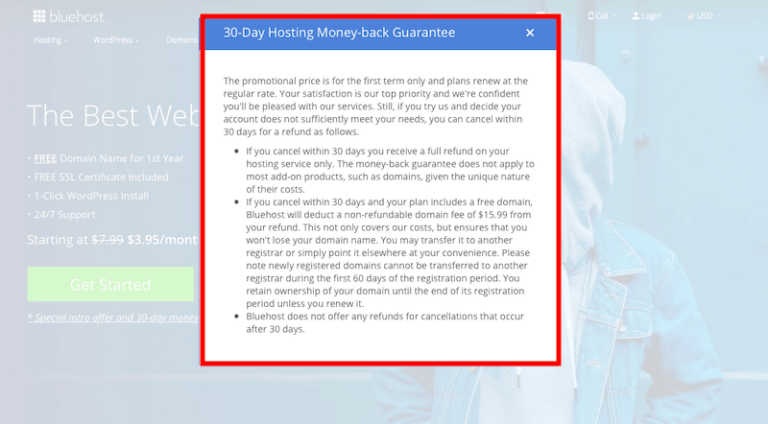
Cons of BlueHost Hosting:
1. Price hike during renewal
All hosting companies increase their prices when it is time for renewal, and BlueHost is not an exception.
BlueHost offers small introductory rates to secure you as a customer but the rate increases when it comes to renewal.
This is the usual norm that every hosting company implements. After the initial term, you will have to pay a higher monthly rate than you first spent.
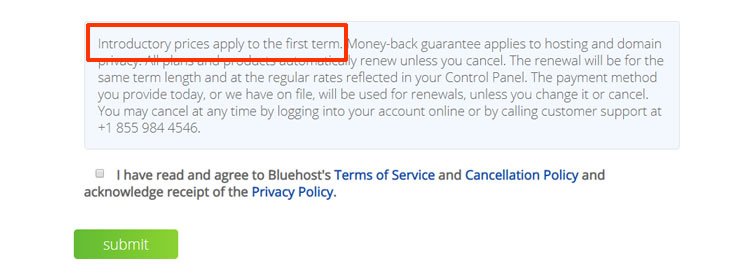
2. No Free Site Transfer
Unlike well-known web hosts like SiteGround, Bluehost does not offer free migrations when you move an existing site to its servers.
For migrating your site over to Bluehost, you have to do it yourself or pay a fee for help. At present, the fee to migrate up to 5 websites and 20 email accounts are $149.99.
However, the good part is that BlueHost’s technical support experts will take full responsibility to provide you with an uninterrupted site transition.
3. U.S. based data centers only
Unfortunately, Bluehost only operates servers in US-based data centers. While this may be a good thing for sites targeting traffic in that region, it unfortunately puts others at an disadvantage.
This is particularly so for sites expecting Asia-region traffic as that zone is literally across the globe.
4. Unlimited hosting has strict limitations on Database Usage.
If you read their policies, you’ll realize that there are certain limitations to their unlimited hosting, such as the fact they do not provide unlimited space for online storage. And this ends up making their “unlimited hosting” quite limited.
Pricing: How Much Does BlueHost Cost?
BlueHost is considered ideal for shared hosting and optimized WordPress hosting. Also, it offers various other hosting options as well.
To help you make a well-informed decision while building your website, here is a breakdown of the BlueHost pricing plans and hosting packages:
A. Shared Hosting
Shared hosting is one of the most popular forms of web hosting in the world. And one of the main reasons behind this popularity is its low cost.
Normally, most of the website owners don’t actually scale their sites large enough to require upgrading to a higher level of hosting, so they stick to shared hosting.
BlueHost offers four types of shared hosting packages:

If you are just getting started, then the Basic plan ($3.95/mo) will be an ideal choice for you. You can later upgrade to a more advanced plan once your site grows.
If you like the Plus plan ($5.85/mo), I believe it’s more advantageous to opt for the Choice Plus plan ($5.95/mo) instead as both the plans come with a similar pricing structure.
The Choice Plus plan comes with extra features, which includes more extensive site backups, domain privacy add-ons, and more.
The Pro plan ($13.95/mo) comes with extra benefits, including unlimited bandwidth, website space, support for a limitless number of websites, dedicated IP addresses, including Email protection and Server Script requirements, and more.
Shared hosting is a great option if you are building your website for the first time.
It is the cheapest hosting option and still comes loaded with enough functionalities and has all the resources required for your site to grow.
B. VPS Hosting
VPS hosting functions just like a dedicated server, but it’s much cheaper than having your own physical dedicated server.
It uses virtualisation technology to build a virtual dedicated server across several shared servers.
You will be still sharing a physical server with other users, but there will be no overlap with other users and your server resources won’t be affected in any way.
BlueHost’s VPS hosting plans consist of these features:
- 2-4 Cores
- 1-2 IPs
- 2-8 GB of RAM
- cPanel and Root Access
- A free domain name for first year
- 30 GB – 120 GB SSD Storage
- Multi-server management & File Management
- Add-On options like Domain Privacy, SiteLock, SEO Tools, and more
BlueHost offers three types of VPS hosting packages:

The main difference among the plans is the amount of storage space, bandwidth and RAM. With the higher-level plans, you’ll also gain access to more IP addresses.
The Standard plan costs $19.99 per month, the Enhanced plan costs $29.99 per month, and the Ultimate VPS plan costs $59.99 per month.
You can choose your plan according to your storage requirements, and the level of bandwidth that you need.
Website owners who have outgrown their shared hosting should consider upgrading to VPS with time.
It is scalable, and your site will perform better when you are starting to get more traffic to your site.
Also, this type of hosting provides greater levels of server customization while implementing fewer site limitations and you will get a super-fast SSD storage.
C. Dedicated Server Hosting
Dedicated Server Hosting enables you to rent an entire physical dedicated server. But it comes with a high price tag as it gives you the sole ownership of your server.
However, the advantages are many. You can avail a massive amount of storage, total server customization, top-notch performance, along with an unmatched level of security.
BlueHost offers three types of Dedicated Server Hosting packages:
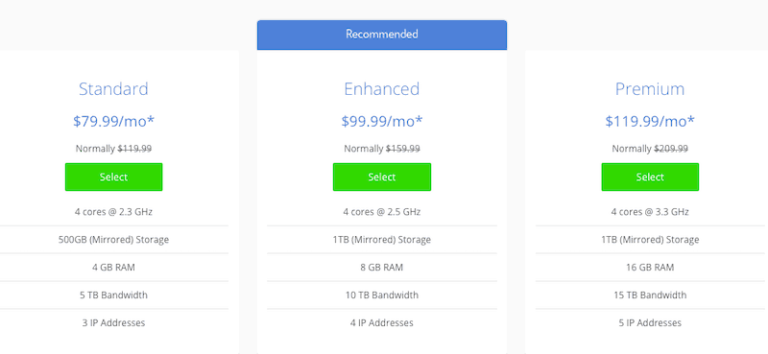
The Standard plan costs $79.99 per month and is the cheapest dedicated plans. The Enhanced plan will cost you $99.99 per month, and the Premium plan is priced at $119.99 per month.
The significant differences between the plans are the overall storage space, RAM, server speed, and the number of dedicated IP addresses.
A dedicated server is opted by those who require complete control over their server environment.
Moreover, if you want to customise the server to align with your business needs, then Dedicated Hosting is the best option you have.
It provides you with a ton of storage, RAM and bandwidth – basically an all-in-one top-performing server environment.
Normally, large sites with a high volume of traffic tend to use dedicated servers. Also, if your website requires very high levels of security, a dedicated server is an ideal choice.
For instance, if you deal with sensitive financial information or other personal information, consider using this hosting.
D. Managed WordPress Hosting
If you’re planning to build a WordPress site, managed WordPress hosting is the best option to go for.
This way you will get a hosting environment that is optimised for your website right from the beginning.
Your website’s performance level will also increase, and you will achieve higher levels of security.
Managed WordPress Hosting comes with the following additional features as well:
- All-in-one marketing center and dashboard
- SEO, email marketing, and social media tools
- Unlimited websites & domains
- No traffic limits
- Optimized performance
- Unlimited web storage
You will also gain access to an advanced cPanel built only for WordPress, SiteLock security, and a free SSL certificate.
BlueHost offers three types of Managed WordPress Hosting packages:
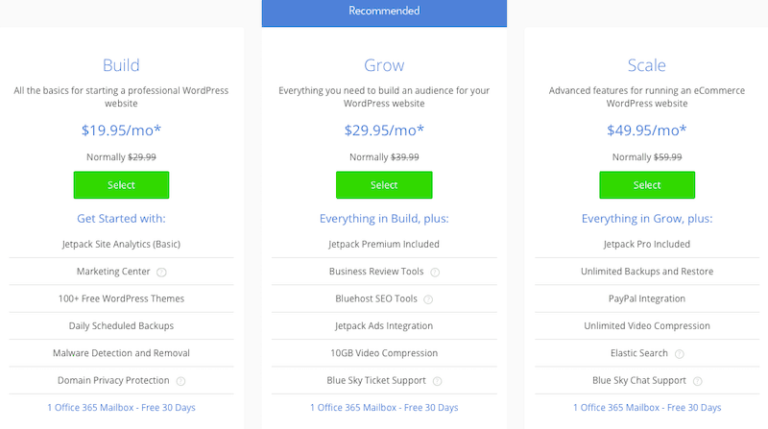
Every Bluehost’s WordPress hosting plans come pre-installed with WordPress, making it easy to build a WordPress site from scratch.
The only differences among the plans lie in storage, RAM, integrated CDN, backup sizes, security, level of SSL certificate, and the total number of visitors allowed per month.
Managed WordPress hosting is suitable for hosting a WordPress site.
If you are just getting started with your first WordPress site, then you probably won’t require a managed WordPress hosting right away.
A basic shared hosting plan will be enough. But when you start getting enough traffic, you may consider upgrading to this plan.
For a medium-sized WordPress site owner with a fast-growing site, it will be ideal to upgrade to Managed WordPress hosting.
If you’re planning to build a website with an eCommerce platform, you can use the WooCommerce WordPress combination, supported by a robust hosting platform.
E. Reseller Hosting
Bluehost’s Reseller Hosting is powered by ResellerClub and is ideal for someone who runs an agency that manages client sites.
If you already are a Bluehost customer, you will get 35% off.
This plan allows you to provide VPS, dedicated, and WordPress hosting to your clients. You can offer customized control panels, sell over 800 different hosting-related products, 24/7 customer support, and more.
The pricing will vary depending on the type of hosting you want.

5 Simple Steps To Sign Up With BlueHost:
Step 1: Visit bluehost.com
When you visit bluehost.com, you will see a “Get Started” button on their homepage. Click on it to enter information and continue with the signup process.

Step 2: Select a Web Hosting plan
Next, you will be redirected to a new page where you will see 4 Shared Hosting Plans, namely Basic, Plus, Prime, and Business Pro.
The Basic plan is highly recommended for beginners.
You can host 1 website with 50GB of space. You’ll get a free SSL and a free domain for a year alongwith unmetered bandwidth and 5 email accounts with 100MB per account.
The Plus, Prime, and Pro packages will benefit you if you intend to run several websites at once or if you are about to launch an eCommerce site.
These packages enables you to host limitless websites with unmetered space and you get unlimited email accounts with limitless storage space.

Step 3: Select a Domain Name
When you pick a plan, you will be prompted to enter your domain name.
Here you’ll see two options:
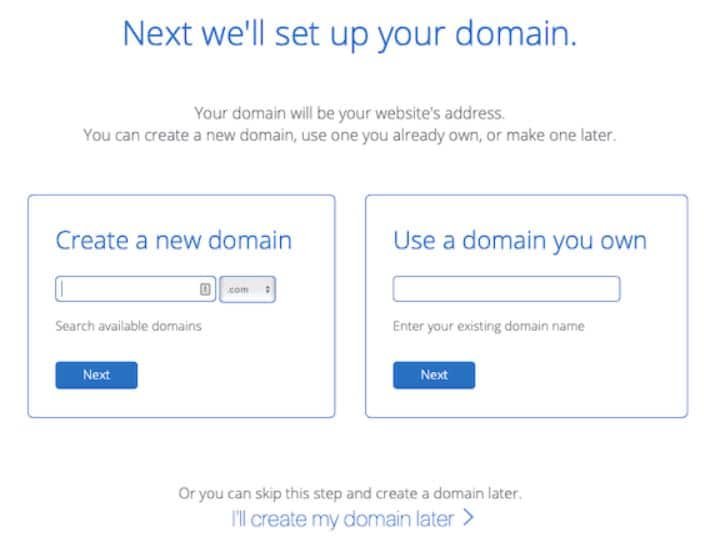
You can either register a “new domain,” which is absolutely free for the first year.
Or if you already own a domain, then choose “I have a domain name” option.
Next you need to decide whether you want your website to be .com, .org, .net, and so on.
Step 4: Enter Your Personal Details
Once you pick your domain name or leave it for later on, you can move to the next step and enter your “Personal Information” to create your account.
Here, you’ll have to enter details such as your first and last name, email address, password, country, phone number, and so on.

Next, scroll down to the “Package Information” section.
Here you need to choose for how long you want your Bluehost package to last (12, 24, or 36 months) and select a few add-ons.
Usual add-ons, include Codeguard Basic, SiteLock Security Find, and Bluehost SEO Tools Start.
You are unlikely to require all the add-ons, so make sure to choose only the add-ons that align with your needs.

After that, you just have to pick a payment option. Bluehost offers two payment options – via credit card or PayPal.
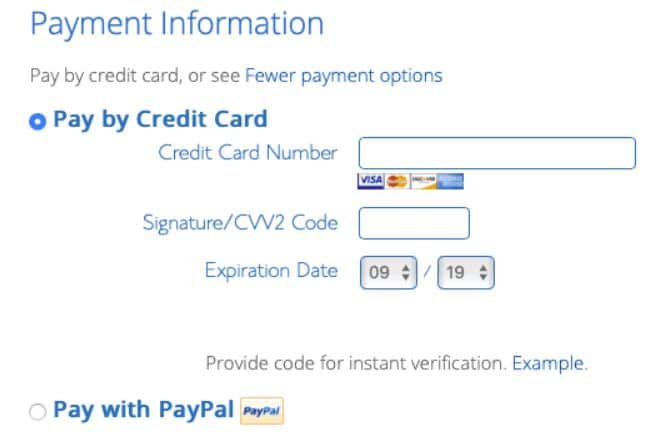
Step 5: You’ve Successfully Signed Up With BlueHost
That’s it! You have finally signed up for BlueHost.
Now, hit the “Submit” button and Bluehost will send you a welcome email confirming your hosting account.
It will include all the login details that you need to get started.
Once you are done with the signup process, you can choose to install WordPress from the cPanel.
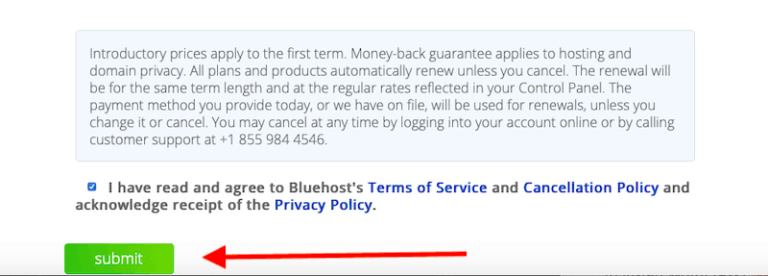
How To Connect Domain With BlueHost?
Adding Domain During Publication:
For this, you will need to access the Bluehost Builder Editor. Once you are ready to publish your site:
- Click the Publish button located at the top right corner.
- You will see a progress window pop up. Once published, this will show your temporary URL.
- Click the Choose Domain button.
- Select your domain from the drop-down menu. Here the domains assigned to your Bluehost account will show up.
Click the Connect this domain button.
Adding Domain After Publication:
For changing the domain after you’ve published your site, use the Bluehost Builder Settings tab, once you are signed in to your BlueHost account.
- Open the My Sites tab from the side navigation menu to the left.
- Select the Bluehost Builder site you wish to update the name for, and click the Manage Site button.
- Open the Settings tab.
- Click on the Change domain button.
- Select your preferred domain from the drop-down.
- Click the Connect this domain button.
After this just publish your website to see your domain changes reflected live.
Final Verdict
BlueHost comes with one of the lowest pricing plans in the industry. If you are a startup or a small business, Bluehost is one of the best options you have.
Since Bluehost is scalable, you can always upgrade your plan to a higher plan later as your business starts to grow.
As a beginner, I learned a lot from BlueHost’s extensive tutorials and I believe it’s ideal for someone who is starting a new blog or creating a portfolio website. The basic plan covers most of the things you require as a newbie.
Along with a free SSL certificate and a free domain for a year, you get a 30-day money-back guarantee, robust security, great customer support, plenty of user-friendly apps, and much more.
Overall, I think BlueHost is an excellent choice for small businesses and website owners who are looking for a budget hosting solution.
It offers tons of the latest security and performance features – NGINX architecture, custom server cache, HTTP/2, SSD storage, etc.

If you find this article helpful, kindly share it with your friends. You may also Pin the above image on your Pinterest account. Thanks!
Most Common BlueHost FAQ:
What is BlueHost?
BlueHost is a well-established web hosting company known for providing hosting solutions to individuals and businesses.
They offer a wide range of hosting services, including shared hosting, VPS hosting, dedicated hosting, and WordPress hosting, making them a versatile choice for various web hosting needs.
BlueHost is particularly renowned for its user-friendly approach and robust customer support.
How long has BlueHost been in business?
BlueHost has been in business since 2003, which means they have over two decades of experience in the web hosting industry.
This longevity speaks to their reliability and ability to adapt to changing technologies and customer needs over the years.
Where is BlueHost located?
BlueHost is headquartered in Orem, Utah, United States. While they have a physical presence in Utah, they provide hosting services to customers worldwide, serving millions of websites from their data centers.
Is BlueHost a reliable web hosting provider?
Yes, BlueHost is generally considered a reliable web hosting provider. They have a strong reputation for uptime and server performance, ensuring that websites hosted with them remain accessible to visitors.
However, the reliability of any hosting service can vary depending on factors like the specific hosting plan chosen and website optimization.
What types of hosting services does BlueHost offer?
BlueHost offers a variety of hosting services, including shared hosting, VPS hosting, dedicated hosting, and cloud hosting.
Additionally, they have specialized WordPress hosting and WooCommerce hosting packages, making them suitable for a wide range of website types and sizes.
How much does BlueHost hosting cost?
BlueHost’s hosting prices vary depending on the type of hosting and the specific plan you choose. Shared hosting plans typically start at around $2.95 per month, while VPS hosting plans can range from $18.99 to $59.99 per month.
Dedicated hosting and cloud hosting plans have higher pricing tiers, depending on the level of resources and features you require.
Does BlueHost offer a free trial?
BlueHost does not provide a free trial, but they do offer a money-back guarantee. If you are not satisfied with their services within the first 30 days of signing up, you can request a full refund, minus any domain registration fees.
Are there any coupons available for BlueHost hosting?
Yes, BlueHost occasionally offers promotional discounts and coupons, especially for new customers. Right now, you can get 70% discount on the hosting plans.
Does BlueHost offer shared hosting?
Yes, BlueHost offers various shared hosting plans which is a cost-effective option for small websites and beginners.
Does BlueHost offer VPS hosting?
Yes, BlueHost offers VPS hosting, with various plans designed to accommodate different resource needs and budgets.
Does BlueHost offer dedicated hosting?
Yes, BlueHost offers dedicated hosting plans for customers who require a dedicated server environment. Dedicated hosting provides users with an entire physical server dedicated to their website or application, offering maximum control and performance.
Does BlueHost offer cloud hosting services?
Yes, BlueHost offers cloud hosting services that leverage cloud infrastructure to provide scalability and reliability. Their cloud hosting plans are suitable for websites and applications that require flexibility and resource scaling.
Can I host WordPress websites on BlueHost?
Yes, BlueHost is a recommended hosting provider by WordPress.org, and they offer specialized WordPress hosting plans. These plans are optimized for WordPress performance and come with features like automatic updates and security enhancements.
What is BlueHost's WordPress hosting?
BlueHost’s WordPress hosting is a set of hosting plans designed specifically for WordPress websites. They include features like one-click WordPress installation, automatic updates, and enhanced security to make managing a WordPress site easier and more efficient.
Does BlueHost offer e-commerce hosting solutions?
Yes, BlueHost provides hosting solutions for e-commerce websites. They offer WooCommerce hosting, which is tailored to online stores powered by the WooCommerce plugin for WordPress. These plans come with e-commerce features and tools to help businesses sell products and services online.
What are BlueHost's customer support options?
BlueHost offers various customer support options, including 24/7 live chat, phone support, and a ticket-based email system.
Their customer support team is known for being responsive and knowledgeable, assisting customers with technical issues and inquiries.
Is BlueHost's customer support available 24/7?
Yes, BlueHost provides 24/7 customer support, ensuring that you can reach out for assistance at any time, day or night. This is particularly important for resolving urgent issues or technical problems promptly.
What is BlueHost's uptime guarantee?
BlueHost offers an uptime guarantee of 99.9%. This means they strive to keep your website accessible to visitors 99.9% of the time. If they fail to meet this guarantee, they may offer compensation or service credits.
How do I transfer my website to BlueHost?
Transferring your website to BlueHost involves several steps, including backing up your current site, moving files and databases, and updating DNS records. BlueHost provides helpful guides and support to assist you in the migration process.
Does BlueHost offer a money-back guarantee?
Yes, BlueHost offers a 30-day money-back guarantee. If you are not satisfied with their services within the first 30 days of signing up, you can request a full refund, minus any domain registration fees.
Can I register a domain through BlueHost?
Yes, BlueHost offers domain registration services, allowing you to register and manage domain names directly through their platform.
They provide a user-friendly domain management interface and often include a free domain with certain hosting plans.
How many websites can I host on a BlueHost account?
The number of websites you can host on a BlueHost account depends on the hosting plan you choose. Shared hosting plans typically allow hosting for one website on the basic plan and unlimited websites on higher-tier plans.
VPS and dedicated hosting plans can accommodate multiple websites based on resource allocation.
What is cPanel and does BlueHost use it?
cPanel is a popular web hosting control panel that provides tools for managing various aspects of your hosting account, including files, databases, and email.
Yes, BlueHost uses cPanel as its control panel, making it familiar to many web hosting users.
How do I install SSL certificates on my BlueHost hosted website?
BlueHost offers free SSL certificates through Let’s Encrypt, which can be easily installed through the control panel. You can also purchase and install premium SSL certificates for added security and trust for your website visitors.
What is the BlueHost control panel like?
BlueHost uses cPanel as its control panel, which is known for its user-friendly interface and robust features. With cPanel, you can manage files, databases, domains, email accounts, and other aspects of your hosting account efficiently.
Does BlueHost provide automatic backups?
Yes, BlueHost offers automatic daily, weekly, and monthly backups for your website data. These backups help ensure that you can restore your website in case of data loss or unforeseen issues.
Can I use BlueHost for email hosting?
Yes, BlueHost provides email hosting services, allowing you to create and manage email accounts associated with your domain. You can use email clients or webmail to access your email.
What is BlueHost's email hosting service called?
BlueHost’s email hosting service is typically included with their hosting plans and is simply referred to as “BlueHost Email.”
Does BlueHost offer a website builder?
Yes, BlueHost offers a website builder called “BlueHost Website Builder.” It is a user-friendly tool that allows you to create and customize websites without needing extensive technical knowledge.
Can I create an online store with BlueHost?
Yes, you can create an online store with BlueHost by using their WooCommerce hosting plans or integrating e-commerce plugins into your WordPress website hosted on BlueHost.
Does BlueHost offer a content delivery network (CDN)?
BlueHost provides integration with Cloudflare, a popular CDN service, as part of their hosting packages. This integration can help improve website performance and security by serving content from geographically distributed servers.
What security features does BlueHost provide?
BlueHost offers various security features, including SSL certificates, malware scanning and removal, and access to a web application firewall (WAF). They also have security experts who monitor and respond to potential threats.
Is BlueHost suitable for beginners?
Yes, BlueHost is considered beginner-friendly due to its user-friendly control panel, one-click installation options for applications like WordPress, and robust customer support. It’s a suitable choice for those new to web hosting.
What programming languages are supported on BlueHost?
BlueHost supports a wide range of programming languages, including PHP, Ruby on Rails, Perl, Python, and more. Their hosting environment is versatile, accommodating various scripting languages and technologies.
Can I host a forum or community website on BlueHost?
Yes, you can host a forum or community website on BlueHost. You can use popular forum software like phpBB or Discourse, which can be installed through the control panel or manually.
What is BlueHost's stance on resource usage and fair usage policy?
BlueHost has a resource usage policy that outlines the limits on CPU, memory, and other server resources to ensure fair usage for all customers. Excessive resource usage may lead to temporary restrictions or upgrade recommendations.
How do I cancel my BlueHost hosting account?
To cancel your BlueHost hosting account, you can contact their customer support through live chat, phone, or email. They will guide you through the cancellation process, which typically involves verifying your identity and confirming the cancellation request.
What is BlueHost's renewal pricing like?
BlueHost’s renewal pricing is often higher than the initial promotional pricing. It’s essential to review the renewal rates before signing up for a hosting plan to understand the long-term costs.
Can I use BlueHost for reseller hosting?
BlueHost primarily focuses on shared, VPS, and dedicated hosting for individual websites and businesses. They do not offer specialized reseller hosting plans but they do recommend ResellerHub.
Does BlueHost provide SSH access?
Yes, BlueHost provides SSH (Secure Shell) access for more advanced users who need command-line access to their hosting environment. This feature allows for greater control and customization.
What is BlueHost's data center infrastructure like?
BlueHost operates multiple data centers, each equipped with redundant power, cooling, and network infrastructure to ensure high availability. These data centers are designed to provide reliable hosting services.
How do I add additional domains to my BlueHost account?
You can add additional domains to your BlueHost account by using the control panel. Depending on your hosting plan, you can add domains as add-on domains or parked domains and manage their settings accordingly.
What is BlueHost's website migration service?
BlueHost offers a website migration service for customers who want to transfer their websites from other hosting providers to BlueHost. This service is typically provided free of charge and includes moving website files, databases, and configurations.
Can I use BlueHost for podcast hosting?
While BlueHost primarily focuses on web hosting, including websites with podcast-related content, such as a podcast website or blog. However, for actual podcast media hosting, you may need to consider specialized podcast hosting platforms.
How do I access my BlueHost hosting account?
To access your BlueHost hosting account, you can log in through the BlueHost website using your account credentials. Once logged in, you can access the control panel and manage your hosting settings and resources.
Does BlueHost offer a website backup and restore feature?
Yes, BlueHost offers website backup and restore features. They automatically back up your website data, and you can restore it from the control panel in case of data loss or errors.
Can I create subdomains with BlueHost?
Yes, you can create subdomains on BlueHost by using the control panel. Subdomains allow you to create additional sections or microsites under your main domain.
What is BlueHost's policy on server resource allocation?
BlueHost’s server resource allocation policies are designed to ensure that all users on a shared server have fair access to resources. If a website consumes excessive resources, it may be asked to upgrade to a more suitable hosting plan.
Does BlueHost offer website builder templates and themes?
Yes, BlueHost provides a selection of website builder templates and themes to help users create visually appealing and functional websites with ease.
These templates cover various industries and design styles, allowing you to customize your website’s appearance to suit your brand or preferences.
Can I use BlueHost for Windows hosting?
BlueHost primarily offers Linux-based hosting solutions. If you specifically require Windows hosting, you may need to explore other hosting providers that specialize in Windows environments.
What is the maximum file size I can upload to BlueHost?
The maximum file size you can upload to BlueHost may vary depending on your hosting plan and server configuration. However, as a general guideline, many hosting providers set limits between 2GB and 5GB for file uploads.
How do I upgrade my BlueHost hosting plan?
You can upgrade your BlueHost hosting plan by logging into your BlueHost account and navigating to the account settings or contacting BlueHost’s customer support. They will guide you through the upgrade process, which may involve changing your hosting plan or adding additional resources.
Can I use BlueHost for a photography portfolio website?
Yes, BlueHost is suitable for hosting photography portfolio websites. You can showcase your photography work by creating a website using platforms like WordPress, and BlueHost’s hosting plans support image-heavy websites.
Does BlueHost provide website analytics tools?
BlueHost offers basic website analytics tools within the control panel, such as visitor statistics and traffic reports. However, for more advanced analytics, many website owners integrate third-party services like Google Analytics.
How do I set up an SSL certificate on my BlueHost website?
Setting up an SSL certificate on your BlueHost website can be done through the control panel. BlueHost offers a free Let’s Encrypt SSL certificate, and you can install it with a few clicks. Alternatively, you can purchase and install premium SSL certificates for added security.
Can I use BlueHost for video hosting?
While BlueHost is primarily designed for web hosting, including websites with video content, it may not be the best choice for high-bandwidth video hosting. For extensive video hosting needs, specialized video hosting platforms are recommended.
What is BlueHost's stance on data privacy and security?
BlueHost takes data privacy and security seriously. They have policies and measures in place to protect customer data and are compliant with various data protection regulations, including GDPR in Europe.
Does BlueHost offer a website staging environment?
BlueHost provides a website staging feature on some of its hosting plans. This allows you to create a duplicate of your website for testing and development purposes before making changes to your live site.
What security measures does BlueHost have in place to protect against DDoS attacks?
BlueHost employs various security measures to mitigate the risk of Distributed Denial of Service (DDoS) attacks.
These measures include network monitoring, traffic filtering, and the use of Content Delivery Networks (CDNs) like Cloudflare to help absorb and block malicious traffic during potential DDoS attacks.
It’s essential to review BlueHost’s specific DDoS protection features and policies to ensure your website’s security.
How do I change my BlueHost account password?
You can change your BlueHost account password by logging into your BlueHost account and navigating to the account settings or security settings section. Follow the prompts to update your password securely.
What are BlueHost's server specifications?
BlueHost uses modern server hardware, including powerful processors, ample RAM, and fast SSD storage. The exact specifications may vary depending on the hosting plan and data center location.
Does BlueHost offer a money-back guarantee for VPS hosting?
Yes, BlueHost provides a 30-day money-back guarantee for their VPS hosting plans, similar to their shared hosting plans. If you are not satisfied with the service within the first 30 days, you can request a refund.
How do I create a database on BlueHost?
To create a database on BlueHost, you can use the control panel, which typically includes tools like phpMyAdmin or a database management section. You can create and manage databases for your website and applications from there.
Can I use BlueHost for a membership website?
Yes, BlueHost can host membership websites, provided you use the appropriate content management system (CMS) or plugins to create and manage user accounts and access restrictions.
What is BlueHost's policy on server resource usage?
BlueHost has a resource usage policy in place to ensure fair use of server resources by all customers. Excessive resource consumption by a website may lead to temporary restrictions or upgrade recommendations to a higher-tier plan.
Can I use BlueHost for non-profit websites?
Yes, BlueHost is a suitable choice for non-profit organizations looking to host their websites. They offer affordable hosting plans and have tools to help non-profits establish an online presence.
How do I add an addon domain to my BlueHost account?
You can add an addon domain to your BlueHost account by accessing the control panel and navigating to the domain or hosting settings. Follow the provided instructions to add the domain and configure its settings.
Can I install custom applications on BlueHost?
Yes, you can install custom applications on BlueHost, provided they are compatible with the hosting environment. BlueHost supports various scripting languages and offers tools like the Softaculous one-click installer to simplify the application installation process.
Does BlueHost provide a website performance optimization service?
BlueHost offers some website performance optimization features, such as caching and content delivery integration with Cloudflare.
However, advanced performance optimization may require additional efforts, like optimizing website code and assets.
Can I use BlueHost for a blog website?
Yes, BlueHost is an excellent choice for hosting blog websites. You can use popular blogging platforms like WordPress to create and manage your blog easily.
What is BlueHost's policy on spam and email marketing?
BlueHost has strict anti-spam policies and does not tolerate spam or unsolicited email marketing. Violations of their policies may lead to account suspension or termination.
How do I manage my DNS settings on BlueHost?
You can manage your DNS settings on BlueHost by accessing the control panel and using the DNS management tools provided. This allows you to configure domain settings, such as DNS records and nameservers.
What is BlueHost's policy on automatic account suspension?
BlueHost may automatically suspend accounts that violate their terms of service, including excessive resource usage, spam, or other policy violations. Suspended accounts are subject to review and may require corrective actions to be reinstated.
How do I create a subdirectory on BlueHost?
You can create a subdirectory on BlueHost by accessing the file manager or FTP client provided in the control panel. From there, you can create a new folder and configure it as a subdirectory for your website.
Can I use BlueHost for a gaming server?
BlueHost’s shared hosting plans are not suitable for hosting gaming servers due to resource limitations. However, you can explore specialized hosting providers that offer game server hosting solutions for gaming communities.
What is BlueHost's policy on domain privacy protection?
BlueHost offers domain privacy protection as an optional service. This feature allows you to keep your personal contact information private by replacing it with BlueHost’s contact information in the public domain registration records.
How do I change my BlueHost account billing information?
To change your BlueHost account billing information, you can log into your BlueHost account and navigate to the billing or account settings section. From there, you can update your payment details, billing address, and other billing information.
What is BlueHost's policy on data retention and backups?
BlueHost retains backup copies of customer data for a limited duration, typically 30 days. Customers are encouraged to maintain their own backups as well, especially for critical data, to ensure data integrity and availability beyond the hosting provider’s retention period
Does BlueHost offer dedicated IP addresses and how can I obtain one?
Yes, BlueHost does offer dedicated IP addresses as an optional service. A dedicated IP address can be useful for specific website needs, such as SSL certificate installation or avoiding potential shared IP address-related issues.
To obtain a dedicated IP address, you can typically request one through your BlueHost account or contact their customer support for assistance and pricing information.
What e-commerce platforms are compatible with BlueHost for hosting online stores?
BlueHost is compatible with various e-commerce platforms, including WooCommerce for WordPress, Magento, OpenCart, and more.
You can choose the e-commerce platform that best suits your online store’s needs and easily integrate it with your BlueHost hosting plan.
Abhigyan Mahanta
Hi! I’m Abhigyan, a passionate remote web developer and writer with a love for all things digital. My journey as a remote worker has led me to explore the dynamic landscape of remote companies. Through my writing, I share insights and tips on how remote teams can thrive and stay connected, drawing from my own experiences and industry best practices. Additionally, I’m a dedicated advocate for those venturing into the world of affiliate marketing. I specialize in creating beginner-friendly guides and helping newbie affiliates navigate this exciting online realm.


